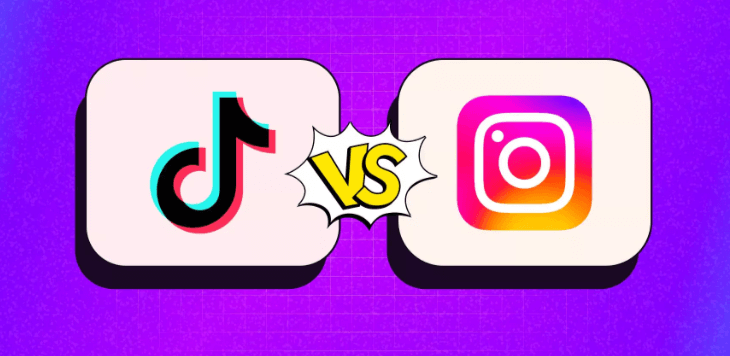Instagram vs. TikTok: Which Platform Is Best for Your Content?

As a content creator or business owner, choosing the right social media platform is essential for reaching your target audience and maximizing engagement. Instagram and TikTok are two of the most popular platforms today, each with its unique set of features, audience demographics, and strengths. Both have redefined how we consume and produce content, but which one is better for your content strategy?
In this article, we’ll dive deep into the comparison between Instagram and TikTok, exploring their strengths, user base, content formats, monetization potential, and more. By the end, you should have a clearer understanding of which platform is best suited to help you achieve your goals.
The Rise of Instagram and TikTok
Instagram, launched in 2010, started as a simple photo-sharing app and has grown into a robust platform with over 1 billion monthly active users. The platform expanded its features over the years, adding Stories, IGTV, Reels, and shopping functionalities. Instagram has traditionally been about polished, curated content with a focus on aesthetics. It’s the go-to platform for influencers, brands, and anyone wanting to showcase a lifestyle-centric feed.
TikTok, launched in 2016, is a video-centric platform known for its short-form content. With over 1 billion monthly users worldwide, TikTok has quickly become the hub of viral trends, dance challenges, and humorous videos. The app allows users to create videos up to 3 minutes long, with a primary focus on creativity, humor, and authenticity.
While both platforms have huge user bases, they differ significantly in terms of audience expectations, types of content, and algorithms. Let’s explore these differences to understand how they affect your content strategy.
Audience Demographics
Knowing your audience is the first step to choosing the right platform for your content. Instagram and TikTok cater to different user demographics.
Instagram has a broad age range, but it’s particularly popular among millennials (ages 25-34), followed closely by Gen Z. Instagram is also widely used by businesses, marketers, and influencers targeting consumers interested in lifestyle, travel, fashion, and food. It tends to attract a slightly older and more professional audience compared to TikTok.
TikTok, on the other hand, is the home of Gen Z. The platform is primarily used by users between the ages of 16 and 24. TikTok’s content is more playful and spontaneous, appealing to a younger crowd looking for quick entertainment. However, older users and brands are starting to embrace the platform as its popularity continues to rise.
Key Takeaway: If your target audience includes millennials and older users with an interest in lifestyle and curated content, Instagram is likely the better choice. If you’re targeting a younger, trend-driven audience, TikTok will give you more reach.
Content Styles and Formats
The style and format of content differ significantly between the two platforms, and understanding this can help you create content that resonates with your audience.
Instagram is all about visually appealing, high-quality images and videos. Users are accustomed to polished content, and feeds often showcase well-edited photos and videos. While Instagram has adapted to short-form content with Instagram Reels (similar to TikTok), the platform is still largely driven by curated posts. Instagram Stories also provide users with a temporary, more candid way to share updates, while IGTV allows for long-form video content.
In contrast, TikTok thrives on raw, creative, and fast-paced videos. The platform allows users to create short clips, often with music, filters, and effects, that embrace spontaneity and authenticity. TikTok’s video-centric format is ideal for quick, trend-based content that encourages engagement through challenges and viral trends. Here, imperfections are embraced, and content that feels more relatable tends to perform better than overly polished videos.
Key Takeaway: If your content focuses on aesthetics, high-quality visuals, and storytelling, Instagram is the better platform. But if you prefer fast-paced, creative, and authentic short-form video content, TikTok is where you should be.
Algorithm and Content Discovery
A major factor influencing your success on either platform is the algorithm. The way content is discovered on Instagram versus TikTok can make a big difference in your content’s reach and visibility.
Instagram’s algorithm has evolved over time, prioritizing content that receives high engagement. This means that users who interact frequently with your content (liking, commenting, sharing, or saving) are more likely to see your posts in their feed. However, the focus remains largely on those who already follow you, making it harder to break through to new audiences unless your content appears in the Explore section or through Instagram Reels.
TikTok’s algorithm is what sets the platform apart. TikTok’s “For You” page is highly personalized, showing users content based on their previous interactions and preferences. The beauty of this algorithm is that it can push content from any user—regardless of their follower count—to a massive audience. As a result, TikTok offers more organic reach and virality, making it easier for new creators to gain visibility and go viral.
Key Takeaway: If you’re looking for rapid growth and viral potential, TikTok offers better opportunities due to its discovery algorithm. If you want to focus on building a loyal, engaged audience over time, Instagram may be a better fit.
Engagement and User Interaction
Both platforms offer high levels of engagement, but the nature of user interaction differs significantly.
On Instagram, engagement often comes through likes, comments, shares, and direct messages. Instagram users tend to engage with content that aligns with their personal aesthetics or interests. Engagement is often driven by visually appealing posts, meaningful captions, and strategic use of hashtags. Instagram Stories and Reels also offer ways to engage users through polls, quizzes, and direct messaging.
On TikTok, engagement is more instantaneous and driven by the viral nature of its content. Users can like, comment, and share videos, but the platform’s hallmark is its challenge culture. Hashtags and trending challenges encourage users to create their own versions of popular content, leading to a highly participatory form of engagement. TikTok users are more likely to interact with content by duetting or remixing it, leading to increased visibility for the original post.
Key Takeaway: If your goal is to foster deep, personal engagement with your audience, Instagram provides more tools for meaningful interactions. But if you want quick, viral engagement and participation, TikTok has the edge.
Monetization and Business Tools
Both Instagram and TikTok offer ways for creators and businesses to monetize their content, though the approaches vary.
Instagram is known for its strong monetization features. The platform allows businesses to run ads, and it offers a robust set of tools for e-commerce through Instagram Shops. Influencers and creators can monetize through sponsored posts, affiliate marketing, and partnerships with brands. Instagram’s focus on curated content makes it ideal for brands looking to drive sales and build a polished online presence.
TikTok is newer to the monetization game, but it’s quickly catching up. Creators can earn through the TikTok Creator Fund, where users are paid based on video performance and engagement. TikTok also offers brand partnerships and live streaming, where users can receive virtual gifts that are converted into monetary rewards. Additionally, TikTok has launched TikTok for Business, a platform offering ad solutions for brands to tap into its massive audience.
Key Takeaway: If your business relies on direct-to-consumer sales and influencer partnerships, Instagram offers more mature tools for monetization. However, TikTok is rapidly developing new ways to monetize content, particularly through viral marketing and brand partnerships.
Influencer Culture
Influencers thrive on both Instagram and TikTok, but the culture around influencers is quite different on each platform.
Instagram influencers often present a polished, aspirational image. They typically work in fashion, travel, beauty, and lifestyle niches, where high-quality visuals are essential. Instagram is known for its long-standing influencer culture, where creators with large followings can charge substantial fees for brand partnerships and sponsored posts.
TikTok influencers, by contrast, are often more casual and relatable. The platform has given rise to micro-influencers, who may not have huge followings but generate high levels of engagement due to their authenticity. TikTok influencers often gain popularity by participating in viral trends and challenges rather than through highly curated content.
Key Takeaway: If your brand or content thrives on polished, aspirational images and lifestyle content, Instagram influencers are your best bet. For more casual, authentic, and trend-driven collaborations, TikTok influencers can help you reach an engaged, younger audience.
Advertising Options
Both platforms offer robust advertising tools, but there are key differences in how ads are delivered and perceived.
Instagram Ads are highly targeted and come in various formats, including feed ads, Stories ads, carousel ads, and shopping ads. Instagram’s connection to Facebook Ads Manager gives advertisers powerful targeting options based on user data. Instagram ads are widely used by businesses for direct sales, lead generation, and brand awareness.
TikTok Ads are newer but growing quickly in popularity. TikTok offers in-feed ads, brand takeovers, and branded hashtag challenges, which allow brands to create interactive campaigns that blend seamlessly with organic content. TikTok ads tend to feel more native and less disruptive, making them more engaging for users.
Key Takeaway: If you’re looking for precise ad targeting and proven conversion tools, Instagram is the better platform. If you’re interested in creative, viral marketing campaigns, TikTok offers exciting advertising opportunities.
Conclusion: Which Platform is Best for Your Content?
When it comes to choosing between Instagram and TikTok, it all depends on your content goals, target audience, and the type of content you enjoy creating.
- Instagram is ideal for businesses and creators focused on polished visuals, long-term engagement, and monetization through established advertising and influencer partnerships.
- TikTok is better suited for creators who thrive on creativity, authenticity, and viral content. If you want to reach a younger audience quickly and enjoy the challenge of short-form video content, TikTok is the platform for you.
In some cases, the best strategy might be to use both platforms, leveraging Instagram for its established influencer culture and monetization tools while tapping into TikTok’s viral potential for faster growth.
FAQs
1. Can I go viral on Instagram like TikTok?
Going viral is generally easier on TikTok because of its “For You” page algorithm, but Instagram Reels offers some opportunities for discovery.
2. Which platform is better for influencers?
Instagram has a more established influencer market, but TikTok is rapidly growing and provides more opportunities for micro-influencers to go viral.
3. Should businesses invest in TikTok ads?
Yes, especially if your target audience is younger. TikTok ads can be highly effective for viral marketing and engaging campaigns.
4. What content works best on Instagram?
Polished, high-quality visuals such as lifestyle, fashion, and travel content perform best on Instagram.
5. Can I make money on TikTok?
Yes, TikTok offers monetization options such as the Creator Fund, brand partnerships, and virtual gifts during live streams.
6. How does Instagram’s shopping feature work?
Instagram allows businesses to set up an online store and link products directly in posts and Stories, making it easy for users to shop.






